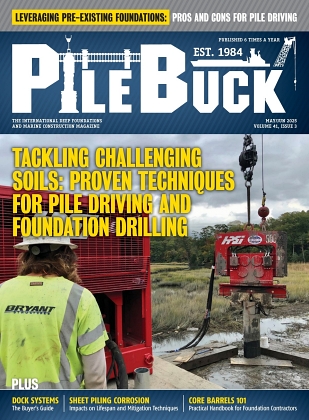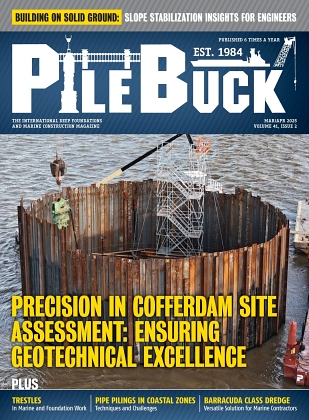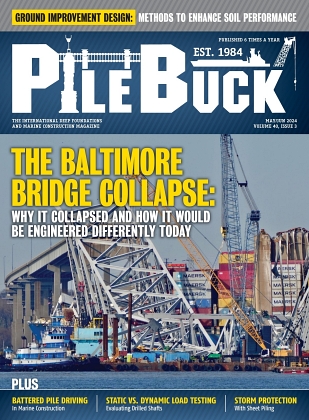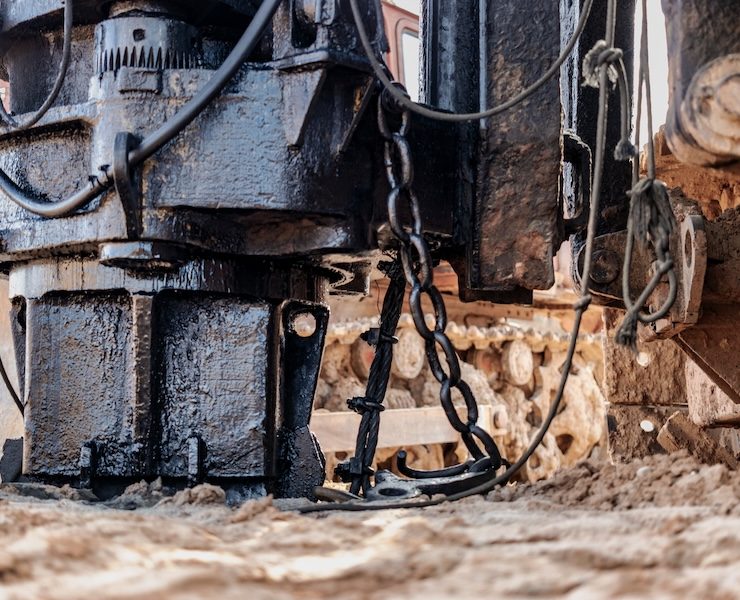An Introduction to Soil Mechanics


By applying the principles of physics, mechanics, hydraulics, strength of materials, and structural engineering – an approach dubbed soil mechanics – geotechnical engineers have gained an understanding of various soil behaviors for a century.
Because the analysis of soil is more complex than that of steel or concrete, which are relatively uniform solids with predictable strength properties, a solution to soil-related problems continues to be achieved via a non-linear approach that leans on a combination of data.
Information generally obtained by field explorations and laboratory tests are relied upon heavily, along with scientific principles from various fields of engineering and science, which predict the behavior of soils under various conditions.
When performing field explorations, investing in an adequate boring and testing program is recommended, as it may prevent costly failures or over conservative design, equating to cost savings.
Various soil analyzation greatly aids in foundation design and serves as a valuable tool for all foundation engineers, many of whom operate in areas previously considered too poor to build upon. In these situations, engineers must be well versed in the fundamentals of soil mechanics before structural foundation or earthwork commences.
Engineers should be able to answer the following questions:
– Will settlements be excessive?
– Can the structure tolerate settlements?
– Will the proposed cut or fill slopes have adequate stability?
Soil Types
The criteria for soil and rock identifications, along with their physical engineering properties are listed below.
Soil will be defined as naturally occurring mineral particles, readily separated into relatively small pieces, and in which the mass may contain air, water, or organic materials. Rock is naturally occurring material composed of mineral particles so firmly bonded that relatively great effort is required to separate them. The mineral particles of the soil mass are formed from decomposition of the rock by weathering and chemical processes.
Sedimentary Soils
Residual material formed by disintegration of underlying parent rock or partially indurated material:
– Residual sands and fragments of gravel size formed by solution and leaching of cementing material. Generally favorable foundation conditions.
– Residual clays formed by decomposition of silicate rocks, disintegration of shales, and solution of carbonates in limestone. Deposits present favorable foundation conditions except in humid and tropical climates, where depth and rate of weathering are very great.
Organic accumulation of highly organic material formed in place by the growth and subsequent decay of plant life:
Peat. A somewhat fibrous aggregate of decayed and decaying vegetation matter having a dark color and odor of decay.
Muck. Peat deposits which have advanced in stage of decomposition to such extent that the botanical character is no longer evident. Both peat and muck are very compressible and entirely unsuitable for supporting building foundations.
Alluvial material transported and deposited by running water
– Floodplain deposits laid down by a stream within that portion of its valley subject to inundation by floodwaters.
– Point bar. Alternating deposits of arcuate ridges and swales. Ridge deposits consist primarily of silt and sand, swales are clay-filled. Generally favorable foundation conditions; however, detailed investigations are necessary to locate discontinuities. Flow slides may be a problem along riverbanks. Soils are quite pervious.
– Channel fill. Deposits laid down in abandoned meander loops isolated when rivers shorten their courses. Composed primarily of clay; however, silty and sandy soils are found at the upstream and downstream ends. Fine-grained soils are usually compressible. Portions may be very heterogeneous. Silty soils generally present favorable foundation conditions.
– Backswamp. The prolonged accumulation of floodwater sediments in flood basins bordering a river. Materials are generally clays but become siltier near riverbanks. Relatively uniform in a horizontal direction. Clays are usually subjected to seasonal volume changes.
– Alluvial Terrace deposits. Relatively narrow, flat- surfaced, river-flanking remnants of floodplain deposits formed by entrenchment of rivers and associated processes. Usually drained, oxidized. Generally favorable foundation conditions.
– Estuarine deposits. Mixed deposits of marine and alluvial origin laid down in widened channels at mouths of rivers and influenced by the tide of the body of water into which they are deposited. Generally fine-grained and compressible. Many local variations in soil conditions.
– Alluvial-Lacustrine deposits. Material deposited within lakes, consisting of unstratified organic clay or clay in central portions of the lake, and grade to stratified silts and sands in peripheral zones. Usually very uniform in horizontal direction. Fine-grained soils generally compressible.
– Deltaic deposits. Deposits formed at the mouths of generally fine-grained rivers that result in extension of the shoreline. Many local variations in soil condition.
– Piedmont deposits. Alluvial deposits at the foot of hills or mountains. Generally favorable conditions.
Aeolian material transported and deposited by wind
– Loess. A calcareous, unstratified deposit of silts, sandy or clayey, traversed by a network of tubes formed by decayed root fibers. Relatively uniform deposits characterized by ability to stand in vertical cuts. Collapsible structure. Deep weathering or saturation can modify characteristics.
– Dune sands. Mounds, ridges, and hills of uniform fine sand characteristically exhibiting rounded grains, very uniform grain size. Exist in relatively loose condition.
Glacial material transported and deposited by glaciers or by meltwater from the glacier
– Glacial till. An accumulation of debris, deposited beneath, at the side or at the lower limit of a glacier. Material lowered to ground surface in an irregular sheet by a melting glacier is known as a ground moraine. Consists of material of all sizes in various proportions from boulder and gravel to clay. Deposits are unstratified. Generally present favorable foundation conditions; however, rapid changes in conditions are common.
– Glacio-Fluvial deposits. Coarse and fine-grained materials deposited by streams of melt water from glaciers. Material deposited on ground surface beyond terminal of glacier is known as an outwash plain. Gravel ridges known as kames and eskers. Generally, these present favorable foundation conditions.
– Glacio-Lacustrine deposits. Materials deposited within lakes by melt water from glaciers. Consisting of clay in central portions of lake and alternate layers of silty clay or silt and clay. Very uniform in a horizontal direction.
Marine material transported and deposited by ocean waves and currents in shore and offshore areas
– Shore deposits. Deposits of sands and/or gravels formed by the transporting, destructive, and sorting action of waves on the shoreline. Relatively uniform and of moderate to high density.
– Marine clays. Organic and inorganic deposits of fine-grained material, generally very uniform in composition. Compressible and usually very sensitive to remolding.
Colluvial material transported and deposited by gravity
– Talus. Deposits created by gradual accumulation of unsorted rock fragments and debris at base of cliffs. Previous movement indicates possible future difficulties. Generally unstable foundation conditions.
– Hillwash. Fine colluvium consisting of clayey sand, sand silt, or clay.
– Landslide deposits. Considerable masses of soil or rock that have slipped down as a unit from their former position on steep slopes.
Pyroclastic material ejected from volcanoes and transported by gravity, wind and air
– Ejecta. Loose deposits of volcanic ash, lapilli and bombs. Shard-like particles of silt with larger volcanic debris. Weathering and redeposition produce highly plastic, compressible clay. Unusual and difficult foundation conditions.
– Pumice. Frequently associated with lava flows and mudflows, or may be mixed with non-volcanic sediments.
Coarse Grained Soils
Defined as those soils where more than half of particles finer than 3” size can be distinguished by the naked eye, coarse grained soils are an excellent foundation material for supporting structures and roads, and regarded as the best embankment material.
The smallest, visible particles of coarse grained soils correspond approximately to the size of the opening of No. 200 sieve used for laboratory identification. Sands are divided from gravels on the No. 4 sieve size, and gravels from cobbles on the 3” size. The division between fine and medium sands is at the No. 40 sieve, and between medium and coarse sand at the No. 10 sieve.
Fine Grained Soils
When more than half of the particles are finer than No. 200 sieve, soils are identified as fine grained. These soils, commonly clay and slit, are classified per plasticity characteristics determined in Atterberg limit tests, and are known for being practically impervious.
Plastic and compressible, fine grained soils are a very poor material for backfill and embankments, as they lose part of their shear strength upon disturbance or wetting.
Organic Soils
Containing an appreciable amount of decayed animal and/or vegetative matter in various states of decomposition, organic soils are characterized by relatively low specific gravity, high water content, high ignition loss, and high gas content.
All organic soils should be viewed with suspicion as foundation and construction materials. The organic matter is objectionable as it reduces the load-carrying capacity of soil, increases compressibility, and frequently contains toxic gasses that are released during the excavation process.
Soil Identification Systems
Soil classification is accomplished via a grouping of tests that includes the Unified System visual inspection, along with Atterberg Limits and sieve analysis. All these tests are relatively easy to perform and market greater allowance for sample disturbance.
Currently private firms and state agencies are increasingly utilizing the terminology of the Unified System but without the classification testing. Instead these parties are utilizing the Modified Unified Description, the process of visually identifying and manually examining soil samples, either in the field or lab, with respect to texture, plasticity and color.
Each identification system enables a geotechnical engineer to make soil property estimates and craft a soil description, which will be relied upon during preliminary design.
To craft a description an engineer must first determine if the soil sample is coarse, fine or mixed grained, or organic. If mixed, does coarse of fine grained predominate?
Next, identify the principal component, using a noun in the soil description terms below. Example, Gravel.
Highlight secondary components, using an adjective in the soil description terms below. Example, Silty Gravel. Provide a definition, i.e. major component gravel size, with non-plastic fines. May contain sand.
Identify any additional components, using another adjective. Silty Gravel, Clayey.
Boulder – A rock fragment, usually rounded by weathering or abrasion, with an average dimension of 12 inches or more.
Cobble – A rock fragment, usually rounded or subrounded, with an average dimension between 3 and 12 inches.
Gravel – Rounded, subrounded, or angular particles of rock that will pass a 3-inch square opening sieve (76.2 mm) and be retained on a Number 10 U.S. standard sieve (2.0 mm).
Sand – Particles that will pass the Number 10 U.S. standard sieve and be retained on the Number 200 U.S. standard sieve (0.074 mm).
Silt – Material passing the Number 200 U.S. standard sieve that is non-plastic and exhibits little or no strength when dried.
Clay – Material passing the Number 200 U.S. standard sieve that can be made to exhibit plasticity (putty like property) within a wide range of water contents and exhibits considerable dry strength.
Fines – The portion of a soil passing a Number 200 U.S. standard sieve.
Marl – Unconsolidated white or dark gray calcium carbonate deposit. May contain granular spheres, shells, organic material or inorganic soils. Reacts with weak hydrochloric acid.
Muck – Black or dark brown finely divided organic material mixed with various proportions of sand, silt, and clay. May contain minor amounts of fibrous material such as roots, leaves, and sedges.
Pest – Organic material in various stages of decomposition.
Organic Clay – Dark grey clay with microscopic size organic material dispersed throughout. May contain shells and/or fibers. Has weak structure that exhibits little resistance to kneading.
Organic Silt – Dark grey silt with microscopic size organic material dispersed throughout. May contain shells and/or fibers. Has weak structure that exhibits little resistance to kneading.
Coarse-Grained Soil – Soil having a predominance of gravel and/or sand.
Fine-Grained Soil – Soil having a predominance of silt and/or clay.
Mixed-Grained Soil – Soil having significant proportions of both fine-grained and coarse-grained sizes.
Fill – Man-made deposits of natural soils and/or waste materials. Document the components carefully since presence and depth of fill are important engineering considerations.
Additional Details to Provide
Color of The Sample. The color description is restricted to two colors. If more than two colors exist, the soil should be described as multi-colored or mottled, and the two predominant colors given.
Moisture condition. Judge by appearance of sample before manipulating. The in-situ moisture content of a soil should be described as dry, moist or wet.
Plasticity. Plastic, Low Plastic, Non-plastic. Note, sample must be in moist or wet condition for plasticity determination. For dry samples requiring wetting make note in description. Plasticity not required for marl, muck and peat.
Structure. Fissured, Blocky, Varved, Layered. Indicate approximate thickness of layers. The description of layering for coarse-grained soils must be made from field observations before sample is removed from sampler.
Particle shape. Coarse-grained soils are described as angular, sub-angular, sub-rounded, or rounded. Gravel, cobbles, and boulders can be described as flat, elongated, or flat and elongated. Descriptions of fine-grained soils will not include a particle angularity or shape.
Additional descriptive terms considered helpful in identifying the soil should be included. Terms include calcareous, cemented, and gritty. Material origins or local names should be included in parentheses.
Word Picture Preparation
A description of the soil sample as determined by the visual-manual procedure, the word-picture should include the following info:
Color of the sample: Brown
Description of Soil Components: Silty Gravel
Moisture Condition: moist
Plasticity: no-nplastic
Particle shape: angular
Other: cemented
Examples:
– Light Grey Silty Clay, moist, plastic, with 1/2 inch layers of wet, grey Silt, non-plastic
– Grey Sandy angular Gravel, Clayey, moist, low plastic
– Red Brown Sand, dry, non-plastic, with roots
-Fill, Brown Sandy subrounded Gravel, with pieces of brick and cinders, wet, non-plastic
What are the key considerations for geotechnical engineers when analyzing soil for construction projects?
Geotechnical engineers consider factors such as settlements, structure tolerance, and slope stability in soil mechanics, relying on a combination of field explorations, laboratory tests, and scientific principles.
How does the choice of soil type impact foundation design, and what are some commonly encountered soil types?
Soil types, including alluvial, residual, aeolian, glacial, marine, colluvial, and organic, have varying characteristics affecting foundation design; for instance, alluvial soils generally offer favorable conditions, while organic soils are unsuitable for building foundations due to their compressibility.

















